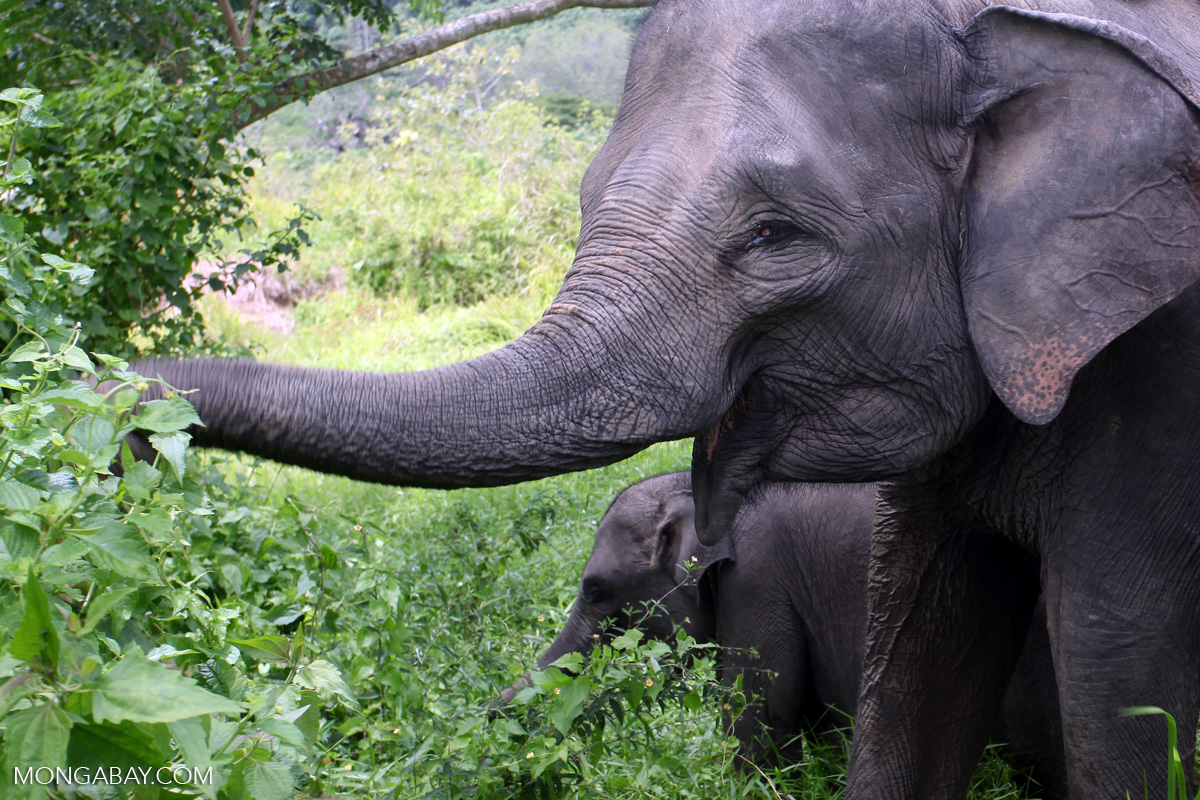- Many large animals – collectively called “megafauna” – eat the fruit of Platymitra macrocarpa trees, including Asian elephants (Elephas maximus), sambar deer (Rusa unicolor), bears and gibbons.
- When researchers examined the fruit consumption, seed dispersal, and seed germination trends of P macrocarpa, they discovered that elephants were responsible for the lion’s share of successful seedling germination – 37 percent – despite consuming only 3 percent of available fruit.
- They also noticed a decline in P macrocarpa, which they say may be due to extirpated rhinos or reductions in local elephant populations.
- They say their results highlight the important role large herbivores play in forest structure, and that losses of these animals might significantly change tree composition and even a forest’s ability to store carbon.
Elephants play a disproportionately large role in spreading the seeds of a particular tree in Thailand, according to a recent study. Its findings indicate that a forest’s composition is likely to change as certain kinds of animals disappear.
The study, published in PLOS ONE, was conducted by researchers primarily from institutions in Thailand who examined the fruit consumption, seed dispersal, and seed germination trends of Platymitra macrocarpa, a member of the custard apple family (Annonaceae). Many large animals – collectively called “megafauna” – eat the fruit of this tree, including Asian elephants (Elephas maximus), sambar deer (Rusa unicolor), bears and gibbons.
Doing so is a win-win for both trees and megafauna – the animals get a meal and the trees get their seeds spread to new areas, complete with a bit of fertilizer to aid their start in life.
For P. macrocarpa, big animals play a big role in its reproduction, with the study finding 78 percent of all sprouted seedlings were at one point in time eaten by megafauna.
But the researchers also found that not all seeds benefit equally by being eaten. When they crunched the data collected in the field, they discovered that elephants were responsible for the lion’s share of successful seedling germination – 37 percent – despite consuming only 3 percent of available fruit. In contrast, sambar, which ate the most fruit, accounted for 17 percent of seedlings. Gibbons and bears were somewhere in the middle.

The researchers observed sambar-eaten seedlings were more likely to be damaged by beetles after being excreted, which could explain why they were less likely to turn into seedlings.
In their study they write that “the megafaunal dispersers had very different dispersal strategies, with the large-herbivore dispersers (sambar deer and bears) unable to replicate the role of the megaherbivore (elephant). Indeed, the decline in SDE values with body size of most dispersers confirms that the different animals often referred to as megafauna can differ substantially in their seed dispersal roles.”
However, while the researchers found that elephants are quite efficient at spreading P. macrocarpa seeds, they note that the tree species is currently on the decline in the region. They say that their findings indicate that P. macrocarpa may be particularly reliant on huge herbivores like elephants – or maybe even something else.
“In relatively recent times, the rainforests of Thailand were inhabited by two megaherbivore taxa–rhinoceros (Sumatran and Javan) and elephant,” the authors write in their study. “Almost no information exists regarding the seed dispersal capacity of a forest rhinoceros, and their populations exist only as relics, having disappeared from almost all of their former ranges. However, forest rhinoceroses are considered primarily browsers, compared to the grazing habits of Asian elephants, and there is anecdotal evidence for them playing a role in seed dispersal.”
The researchers write that this “gap” in P. macrocarp recruitment could be due to extirpated rhinos (which are now relegated to Borneo, Sumatra and Java and staring down the barrel of extinction), or reductions in local elephant populations. Regardless, they write that their study indicates that more common megafauna species like sambar seem to be unable to fill the shoes of bigger animals like elephants when it comes to seed dispersal for certain trees.
And this, says study coauthor Kim McConkey of the National Institute of Advanced Studies in Bangalore in India and BIOTEC in Thailand, could change the character of forests and even their abilities to store carbon and mitigate global warming.
“If less vulnerable large herbivores such as deer are unable to replicate the seed dispersal role of threatened mega-herbivores such as elephants,” McConkey said, “megafaunal fruit could suffer range contractions, affecting forest community composition and potentially forest carbon stocks.”
Citation: McConkey, K. R., Nathalang, A., Brockelman, W. Y., Saralamba, C., Santon, J., Matmoon, U., … & Srinoppawan, K. (2018). Different megafauna vary in their seed dispersal effectiveness of the megafaunal fruit Platymitra macrocarpa (Annonaceae). PloS one, 13(7), e0198960.
Feedback: Use this form to send a message to the editor of this post. If you want to post a public comment, you can do that at the bottom of the page.
